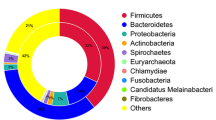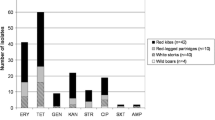Abstract
Antimicrobial resistance has become a global threat to public health since multidrug-resistant (MDR) bacteria have been reported worldwide carrying different antimicrobial resistance genes (ARGs), and animals have been described as a reservoir of ARGs. The presence of antimicrobial-resistant bacteria and ARGs in the food matrix is a risk to public health. This study aimed to research the presence of clinically relevant ARGs for important antimicrobials and genetic elements in fecal samples from dairy cows and calves on a Brazilian farm. In this study, a total of 21 fecal samples were collected, and then, the DNA of cultivable aerobic bacteria was extracted. Fifty-seven ARGs and twenty-three genetic elements were researched by PCR and confirmed by sequencing. Several ARGs that confer resistance to β-lactams, tetracyclines, fluoroquinolones, sulphonamides, phenicols, aminoglycoside, glycopeptides, and macrolides were detected. A total of 200 amplicons from 23 ARGs (blaCTX-M-Gp2, blaCMY, blaSHV, tetA, tetB, tetC, qepA, qnrB, qnrS, oqxA, oqxB, vanC1, vanC2/3, aadA, sul1, sul2, sul3, ermB, mefAE, floR, cmlA, aadA, aph(3′)-Ia, aac(3′)-Ia), and 145 amplicons from 12 genetic elements (IncF, IncFIA, IncFIB, IncI1, IncY, IncU, IncK, IncP, IncR, IncHI1, ColE-like, intI1) were detected. The results presented in this study call attention to the monitoring of antimicrobial resistance in dairy farms worldwide. MDR bacteria and ARGs can spread to different sources, including milk products, which are one of the most consumed products worldwide, representing a potential risk to human health.

Similar content being viewed by others
References
WHO (2017) WHO publishes list of bacteria for which new antibiotics are urgently needed. https://www.who.int/news-room/detail/27-02-2017-who-publishes-list-of-bacteria-for-which-new-antibiotics-are-urgently-needed. Accessed 11 June 2019
Sharp H, Valentin L, Fischer J, Guerra B, Appel B, Käsbohrer A (2014) Estimation of the transfer of ESBL-producing Escherichia coli to humans in Germany. Berl Munch Tierarztl Wochenschr 127:464–477
Hille K, Fischer J, Falgenhauer L, Sharp H, Brenner GM, Kadlec K, Friese A, Schwarz S, Imirzalioglu C, Kietzmann M, Von Münchhausen C, Kreienbrock L (2014) On the occurence of extended-spectrum- and AmpC-beta-lactamase-producing Escherichia coli in livestock: results of selected European studies. Berl Munch Tierarztl Wochenschr 127:403–411
Wichmann F, Udikovic-Kolic N, Andrew S, Handelsman J (2014) Diverse antibiotic resistance genes in dairy cow manure. MBio 5:e01017. https://doi.org/10.1128/mBio.01017-13
Sharma C, Rokana N, Chandra M, Singh BP, Gulhane RD, Gill JPS, Ray P, Puniya AK, Panwar H (2018) Antimicrobial resistance: its surveillance, impact, and alternative management strategies in dairy animals. Front Vet Sci 4:237. https://doi.org/10.3389/fvets.2017.00237
Tanwar J, Das S, Fatima Z, Hameed S (2014) Multidrug resistance: an emerging crisis. Interdiscip Perspect Infect Dis 7:541340. https://doi.org/10.1155/2014/541340
FAO - Food and Agriculture Organization of the United Nations (2016) The FAO action plan on antimicrobial resistance 2016–2020. Rome: Food and Agriculture Organization of the United Nations (2016). http://www.fao.org/3/a-i5996e.pdf. Accessed 11 June 2019
Liu J, Zhao Z, Orfe L, Subbiah M, Call DR (2016) Soil-borne reservoirs of antibiotic-resistant bacteria are established following therapeutic treatment of dairy calves. Environ Microbiol 18:557–564. https://doi.org/10.1111/1462-2920.13097
Franklin AM, Aga DS, Cytryn E, Durso LM, McLain JE, Pruden A, Roberts MC, Rothrock MJ, Snow DD, Watson JE, Dungan RS (2016) Antibiotics in agroecosystems: introduction to the special section. J Environ Qual 45:377–393. https://doi.org/10.2134/jeq2016.01.0023
Carattoli A, Bertini A, Villa L, Falbo V, Hopkins KL, Threlfall EJ (2005) Identification of plasmids by PCR-based replicon typing. J Microbiol Methods 63:219–228. https://doi.org/10.1016/j.mimet.2005.03.018
García-Fernández A, Fortini D, Veldman K, Mevius D, Carattoli A (2009) Characterization of plasmids harbouring qnrS1, qnrB2 and qnrB19 genes in Salmonella. J Antimicrob Chemother 63:274–281. https://doi.org/10.1093/jac/dkn470
Koeleman JG, Stoof J, Van Der Bijl MW, Vandenbroucke-Grauls CM, Savelkoul PH (2001) Identification of epidemic strains of Acinetobacter baumannii by integrase gene PCR. J Clin Microbiol 39:8–13. https://doi.org/10.1128/JCM.39.1.8-13.2001
Ploy MC, Denis F, Courvalin P, Lambert T (2000) Molecular characterization of integrons in Acinetobacter baumannii: description of a hybrid class 2 integron. Antimicrob Agents Chemother 44:2684–2688. https://doi.org/10.1128/aac.44.10.2684-2688.2000
WHO (2016) Critically important antimicrobials for human medicine—5th rev. Geneva, Switzerland. World Health Organization (WHO). Licence: CC BY-NC-SA 3.0 IGO2017. https://www.who.int/foodsafety/publications/cia2017.pdf?ua=1. Accessed 11 June 2019
Bush K, Jacoby GA (2010) Updated functional classification of beta-lactamases. Antimicrob Agents Chemother 54:969–976. https://doi.org/10.1128/AAC.01009-09
Jacoby GA, Strahilevitz J, Hooper DC (2014) Plasmid-mediated quinolone resistance. Microbiol Spectr 2. https://doi.org/10.1128/microbiolspec.PLAS-0006-2013
Krause KM, Serio AW, Kane TR, Connolly LE (2016) Aminoglycosides: an overview. Cold Spring Harb Perspect Med 6:a027029. https://doi.org/10.1101/cshperspect.a027029
Roberts MC, Schwarz S (2016) Tetracycline and phenicol resistance genes and mechanisms: importance for agriculture, the environment, and humans. J Environ Qual 45:576–592. https://doi.org/10.2134/jeq2015.04.0207
Saribas Z, Tunckanat F, Pinar A (2006) Prevalence of erm genes encoding macrolide-lincosamide-streptogramin (MLS) resistance among clinical isolates of Staphylococcus aureus in a Turkish university hospital. Clin Microbiol Infect 12:797–799. https://doi.org/10.1111/j.1469-0691.2006.01486.x
Pallecchi L, Riccobono E, Sennati S, Mantella A, Bartalesi F, Trigoso C, Gotuzzo E, Bartoloni A, Rossolini GM (2010) Characterization of small ColE-like plasmids mediating widespread dissemination of the qnrB19 gene in commensal enterobacteria. Antimicrob Agents Chemother 54:678–682. https://doi.org/10.1128/AAC.01160-09
Carattoli A (2013) Plasmids and the spread of resistance. Int J Med Microbiol 303:298–304. https://doi.org/10.1016/j.ijmm.2013.02.001
Ben Sallem R, Ben Slama K, Rojo-Bezares B, Porres-Osante N, Jouini A, Klibi N, Boudabous A, Sáenz Y, Torres C (2014) IncI1 plasmids carrying bla(CTX-M-1) or bla(CMY-2) genes in Escherichia coli from healthy humans and animals in Tunisia. Microb Drug Resist 20:495–500. https://doi.org/10.1089/mdr.2013.0224
Lyimo B, Buza J, Subbiah M, Temba S, Kipasika H, Smith W, Call DR (2016) IncF plasmids are commonly carried by antibiotic resistant Escherichia coli isolated from drinking water sources in Northern Tanzania. J Med Microbiol 2016:3103672. https://doi.org/10.1155/2016/3103672
Yang QE, Sun J, Li L, Deng H, Liu BT, Fang LX, Liao XP, Liu YH (2015) IncF plasmid diversity in multi-drug resistant Escherichia coli strains from animals in China. Front Microbiol 6:964. https://doi.org/10.3389/fmicb.2015.00964
Locatelli C, Cremonesi P, Caprioli A, Carfora V, Ianzano A, Barberio A, Morandi S, Casula A, Castiglioni B, Bronzo V, Moroni P (2017) Occurrence of methicillin-resistant Staphylococcus aureus in dairy cattle herds, related swine farms, and humans in contact with herds. J Dairy Sci 100:608–619. https://doi.org/10.3168/jds.2016-11797
Furlan JPR, Stehling EG (2018) Detection of β-lactamase encoding genes in feces, soil and water from a Brazilian pig farm. Environ Monit Assess 190:76. https://doi.org/10.1007/s10661-017-6453-x
Netthisinghe AM, Cook KL, Rice C, Gilfillen RA, Sistani KR (2013) Soil nutrients, bacteria populations, and veterinary pharmaceuticals across a backgrounding beef feedlot. J Environ Qual 42:532–544. https://doi.org/10.2134/jeq2012.0203
Kyselková M, Jirout J, Vrchotová N, Schmitt H, Elhottová D (2015) Spread of tetracycline resistance genes at a conventional dairy farm. Front Microbiol 6:536. https://doi.org/10.3389/fmicb.2015.00536
Amador P, Fernandes R, Prudêncio C, Duarte I (2019) Prevalence of antibiotic resistance genes in multidrug-resistant Enterobacteriaceae on Portuguese livestock manure. Antibiotics 8:23. https://doi.org/10.3390/antibiotics8010023
Sawant AA, Hegde NV, Straley BA, Donaldson SC, Love BC, Knabel SJ, Jayarao BM (2007) Antimicrobial-resistant enteric bacteria from dairy cattle. Appl Environ Microbiol 73:156. https://doi.org/10.1128/AEM.01551-06
Slovis NM, Elam J, Estrada M, Leutenegger CM (2014) Infectious agents associated with diarrhoea in neonatal foals in central Kentucky: a comprehensive molecular study. Equine Vet J 46:311–316. https://doi.org/10.1111/evj.12119
Agga GE, Cook KL, Netthisinghe AMP, Gilfillen RA, Woosley PB, Sistani KR (2019) Persistence of antibiotic resistance genes in beef cattle backgrounding environment over two years after cessation of operation. PLoS One 14:e0212510. https://doi.org/10.1371/journal.pone.0212510
Acknowledgments
The authors thank the Fundação de Amparo à Pesquisa do Estado de São Paulo (FAPESP) (grant number 2018/01890-3) and the Coordenação de Aperfeiçoamento de Pessoal de Nível Superior (CAPES) (grant numbers 88882.180855/2018-01, 88887.314388/2019-00 and Finance Code 001) for fellowships.
Funding
This study was supported by Fundação de Amparo à Pesquisa do Estado de São Paulo (FAPESP) (grant number 2018/19539-0).
Author information
Authors and Affiliations
Corresponding author
Ethics declarations
Conflict of interest
The authors declare that they have no conflict of interest.
Additional information
Responsible Editor: Nilton Lincopan.
Publisher’s note
Springer Nature remains neutral with regard to jurisdictional claims in published maps and institutional affiliations.
Electronic supplementary material
ESM 1
(DOCX 26 kb)
Rights and permissions
About this article
Cite this article
Furlan, J.P.R., dos Santos, L.D.R., Ramos, M.S. et al. Fecal cultivable aerobic microbiota of dairy cows and calves acting as reservoir of clinically relevant antimicrobial resistance genes. Braz J Microbiol 51, 1377–1382 (2020). https://doi.org/10.1007/s42770-020-00265-6
Received:
Accepted:
Published:
Issue Date:
DOI: https://doi.org/10.1007/s42770-020-00265-6




